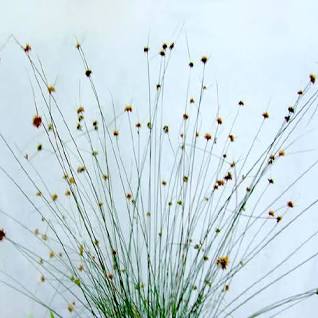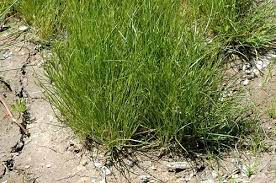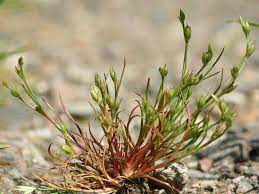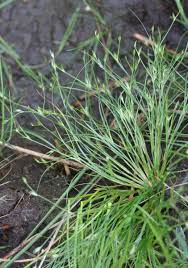Toad rush (Juncus bufonius) is a small, annual or short-lived perennial plant that belongs to the family Juncaceae. This plant is commonly known by several other names, including toad rush, toad rushes, and toad rush grass.
It is found in various regions around the world, including North America, Europe, Asia, and Australia. Toad rush typically thrives in moist habitats, such as wetlands, marshes, riverbanks, and damp meadows.
Toad rush is a low-growing plant with slender, cylindrical stems that can reach heights of up to 40 centimeters (16 inches). The stems are often smooth and hairless, and they may have a reddish or greenish color.
The leaves of toad rush are basal and grass-like. They are usually shorter than the stems and can be somewhat thread-like. Toad rush produces small, inconspicuous flowers that are arranged in compact clusters at the tips of the stems.
The flowers lack showy petals and have a greenish-brown appearance. Toad rush is often found in wet or damp areas, such as the edges of ponds, ditches, and along stream banks.
It can tolerate a range of soil types, including sandy and clayey soils. Toad rush plays a role in stabilizing wetland ecosystems and providing habitat for various aquatic and terrestrial organisms.
It can also contribute to the prevention of soil erosion in wetland areas. Toad rush is an annual or short-lived perennial, meaning it completes its life cycle within a year or a few years. It reproduces by both seeds and vegetative means.
Read Also: How to Grow Your Own Food in Containers
How To Grow Toad Rush Grass (Juncus Bufonius)

Toad rush (Juncus bufonius) is a resilient and adaptable plant that can thrive in various wetland environments. Cultivating this species requires a thoughtful approach, considering its habitat preferences and life cycle.
Here is a comprehensive guide on how to successfully grow Toad rush grass;
1. Site Selection
1a. Wetland Environments: Toad rush naturally inhabits wetlands, so selecting a site with consistently moist conditions is crucial. Ideal locations include the edges of ponds, marshes, ditches, and areas with periodic flooding.
1b. Soil Type: Toad rush exhibits a degree of soil adaptability but prefers well-draining soils. Sandy or loamy soils are suitable, as they prevent waterlogging while retaining sufficient moisture.
2. Planting
2a. Timing: Sow Toad rush seeds in early spring or late fall when soil moisture levels are optimal. Ensure a frost-free period for germination and establishment.
2b. Seed Preparation: To enhance germination, scarify the seeds lightly using sandpaper or a file. Soaking seeds in water for a few hours before planting can also improve results.
2c. Planting Depth: Plant seeds at a depth of 1/8 to 1/4 inch in the soil. Press them lightly into the soil to ensure good seed-to-soil contact.
3. Maintenance
3a. Watering: Maintain consistent soil moisture, especially during the germination and establishment phases. Toad rush thrives in moist conditions but can tolerate short periods of dryness once established.
3b. Weeding: Control competing vegetation to give Toad rush the best chance for growth. Hand weeding is recommended, especially in the early stages, to avoid damaging the delicate plants.
4. Environmental Considerations
4a. Sunlight: Toad rush typically prefers full sun to partial shade. Ensure that the chosen site receives adequate sunlight for successful growth.
4b. Temperature: Toad rush is adaptable to a range of temperatures but may have optimal growth within specific temperature thresholds. Monitor local climate conditions and provide protection during extreme weather events.
5. Harvesting and Propagation
5a. Seed Collection: To propagate Toad rush, collect mature seeds from established plants. Store seeds in a cool, dry place for future sowing.
5b. Vegetative Propagation: Toad rush can also be propagated through division of established clumps. Divide the clumps in early spring or late fall for best results.
6. Ecological Impact
Conservation Awareness: Recognize the ecological importance of Toad rush in wetland ecosystems. Avoid disturbing natural habitats and consider incorporating Toad rush in wetland restoration projects.
7. Monitoring and Troubleshooting
7a. Monitoring Growth:Regularly observe the growth and development of Toad rush to identify any potential issues. Look for signs of stress, disease, or pest infestations.
7b. Pest and Disease Management: Toad rush is generally hardy, but like any plant, it may be susceptible to pests and diseases. Monitor for aphids, mites, or fungal infections, and apply appropriate organic remedies if necessary.
8. Long-Term Care and Propagation
8a. Establishment Period: During the first growing season, focus on establishing a robust root system. Adequate care in the initial stages ensures a healthier and more resilient stand of Toad rush.
8b. Fertilization: Toad rush typically does not require heavy fertilization. If soil conditions are poor, consider a light application of a balanced, slow-release fertilizer in early spring.
8c. Propagation from Cuttings: Experiment with propagating Toad rush from stem cuttings for faster establishment. Take cuttings from healthy, mature plants and root them in a suitable growing medium.
9. Conservation and Restoration Practices
9a. Wetland Restoration: Actively participate in wetland restoration projects to contribute to the conservation of Toad rush habitats. Collaborate with local conservation organizations to enhance biodiversity in wetland ecosystems.
9b. Seed Banking: Consider contributing Toad rush seeds to local seed banks for conservation purposes. Seed banks play a crucial role in preserving genetic diversity and ensuring the long-term viability of plant species.
How To Care For Toad Rush Grass (Juncus Bufonius)

Toad rush (Juncus bufonius) is a modest yet ecologically valuable plant found in various wetland environments. Its presence contributes to the stability of ecosystems and offers habitat benefits. Proper care for Toad rush in agricultural settings is crucial to support its growth and ecological contributions.
Here’s a comprehensive guide on how to cultivate and maintain Toad rush grass;
1. Site Selection: Choose a location with consistently moist soil, mimicking the natural habitats of Toad rush. Wetlands, pond edges, and marshy areas are ideal. Ensure proper drainage to prevent waterlogging, as excessive moisture can adversely affect the plant.
2. Soil Preparation: Toad rush is adaptable to a range of soil types, but it thrives in sandy or loamy soils. Ensure the soil has good organic content. Incorporate well-rotted compost or organic matter to improve soil structure and water retention.
3. Watering: Maintain consistent soil moisture, as Toad rush naturally grows in damp environments. Irrigate regularly to prevent the soil from drying out. Avoid overwatering, as excessively saturated soil may lead to root rot.
4. Sunlight Requirements: Toad rush typically prefers full sun to partial shade. Ensure that the planting site receives an adequate amount of sunlight for healthy growth. In hotter climates, providing some afternoon shade can be beneficial.
5. Planting Toad Rush: Sow Toad rush seeds directly in the prepared soil, ensuring a shallow planting depth of approximately 1/4 inch. Space the seeds or seedlings according to their mature size, allowing for proper air circulation.
6. Weed Control: Regularly inspect the area for invasive weeds that might compete for resources with Toad rush. Hand-weeding or the application of organic mulch can help suppress weed growth without harming the Toad rush.
7. Fertilization: Toad rush typically does not require heavy fertilization. However, a balanced, slow-release fertilizer can be applied in early spring to promote healthy growth. Avoid excessive nitrogen, as it may encourage lush foliage at the expense of flower and seed production.
8. Pruning and Maintenance: Prune dead or damaged stems to encourage new growth and maintain a tidy appearance. Periodically remove debris from the planting area to prevent the accumulation of organic matter that can lead to disease.
9. Propagation: To propagate Toad rush, collect seeds when they are mature and sow them in a controlled environment, or allow the plant to self-seed naturally.
10. Environmental Considerations: Be mindful of local environmental regulations and conservation efforts when cultivating Toad rush, especially in ecologically sensitive areas.
Read Also: How to Start a Community Garden
The Uses and Benefits of Toad Rush Grass (Juncus Bufonius)

Toad rush grass may appear unassuming, but its presence in agricultural and ecological contexts brings forth a range of uses and benefits.
Here is a detailed explanation of the uses of this plant;
1. Soil Erosion Control: Toad rush, with its fibrous root system and low-growing habit, serves as a natural ally in the battle against soil erosion. Planted along water bodies or in areas prone to erosion, this humble plant acts as a stabilizer, preventing the loss of valuable topsoil.
2. Wetland Restoration and Conservation: In wetland ecosystems, Toad rush plays a vital role in restoration efforts. Its adaptability to varying soil conditions and affinity for wet habitats make it a valuable candidate for enhancing biodiversity in degraded wetland areas. The plant provides habitat and sustenance for various aquatic and terrestrial organisms, contributing to the overall health of these ecosystems.
3. Water Filtration: The intricate root system of Toad rush functions as a natural filter, trapping sediments and impurities as water passes through. This capacity for water filtration is particularly beneficial in areas where water quality is a concern, aiding in the purification of aquatic environments.
4. Livestock Forage: Although Toad rush is not traditionally considered a major forage crop, it can offer supplementary grazing material for livestock, particularly in damp meadows or along riverbanks. Its presence adds diversity to the available forage and can be a valuable resource in regions where suitable forage options are limited.
5. Conservation Agriculture Practices: Toad rush aligns with the principles of conservation agriculture. Its ability to stabilize soil, prevent erosion, and contribute to ecosystem health makes it an asset in sustainable farming practices. Integrating Toad rush into agroecosystems can promote long-term soil fertility and resilience.
6. Wildlife Habitat Enhancement: The presence of Toad rush creates microhabitats suitable for various wildlife species. Insects, amphibians, and small mammals find refuge and breeding grounds amidst its dense vegetation, contributing to the overall biodiversity of the agricultural landscape.
7. Educational Value: Beyond its practical applications, Toad rush offers educational opportunities. Studying its life cycle, habitat preferences, and ecological interactions can serve as a hands-on learning experience for agricultural students, fostering an appreciation for the intricate relationships within ecosystems.
8. Biodiversity Promotion: Toad rush’s role in promoting biodiversity extends beyond its immediate surroundings. By providing a suitable environment for various flora and fauna, it contributes to the overall resilience of ecosystems. This, in turn, supports the pollination of crops, pest control, and the maintenance of a balanced ecosystem within and around agricultural areas.
9. Bioindicator of Wetland Health: Toad rush can function as a bioindicator, offering valuable insights into the health of wetland ecosystems. Its presence or absence, along with its growth patterns, can be indicative of changes in water quality, hydrological conditions, and overall ecosystem vitality. Monitoring Toad rush populations aids in early detection of environmental disturbances and informs conservation strategies.
10. Phytoremediation Potential: Research suggests that Toad rush possesses phytoremediation potential, meaning it may play a role in mitigating soil and water pollution. The plant has shown an ability to accumulate certain pollutants, offering a natural and cost-effective approach to environmental cleanup in contaminated areas.
11. Seed Bank Contribution: As an annual or short-lived perennial, Toad rush contributes to the seed bank in its environment. The seeds can persist in the soil, ensuring the regeneration of the plant in subsequent growing seasons. This characteristic adds to the resilience of Toad rush populations and their ability to re-establish in disturbed areas.
12. Low-Maintenance Cover Crop: Toad rush’s adaptability and resilience make it a low-maintenance cover crop option. Its ability to thrive in a variety of soil conditions, including wet and less fertile soils, makes it an attractive choice for areas where other cover crops may struggle. This can be particularly advantageous in sustainable farming systems that aim to minimize external inputs.
In summary, Toad rush emerges as a valuable asset in the agricultural toolkit, offering a range of ecological services and practical benefits. Recognizing its multifaceted contributions can pave the way for informed and sustainable land management practices, where the integration of seemingly modest plants like Toad rush grasses plays a crucial role in building resilient and harmonious agricultural ecosystems.
Frequently Asked Questions on Toad Rush Grass (Juncus Bufonius)
Q1: What is Toad Rush, and where is it commonly found?
Toad Rush, scientifically known as Juncus bufonius, is a small, grass-like plant belonging to the Juncaceae family. Widely distributed across North America, Europe, Asia, and Australia, it thrives in damp ecosystems, including wetlands, marshes, riverbanks, and meadows with moist conditions.
Q2: What are the key characteristics of Toad Rush?
Toad Rush is characterized by slender, cylindrical stems reaching up to 40 centimeters in height. Its smooth, often reddish or greenish stems bear grass-like basal leaves. Inconspicuous greenish-brown flowers form compact clusters at the stem tips.
Q3: How does Toad Rush contribute to wetland ecosystems?
Toad Rush plays a vital role in stabilizing wetland environments. It aids in preventing soil erosion, creating habitat niches for aquatic and terrestrial organisms. As a wetland species, it supports biodiversity by offering refuge and sustenance to various flora and fauna.
Q4: Where does Toad Rush thrive, and what soil conditions does it prefer?
Toad Rush is commonly found along the edges of ponds, ditches, and stream banks. It adapts to a range of soil types, including sandy and clayey soils. Its ability to tolerate different soil conditions makes it a resilient species in wetland ecosystems.
Q5: What is the life cycle of Toad Rush, and how does it reproduce?
Toad Rush is an annual or short-lived perennial plant, completing its life cycle within a year or a few years. It reproduces through both seeds and vegetative means. Understanding its life cycle is crucial for ecological management and conservation efforts in wetland areas.
Q6: How can Toad Rush be beneficial in agricultural settings?
While Toad Rush may not be a conventional agricultural crop, its presence can offer certain benefits. In wetland restoration or conservation agriculture, it can serve as a natural stabilizer, preventing soil erosion and fostering a healthier, more resilient ecosystem. Additionally, Toad Rush may contribute to nutrient cycling and water filtration in wetland areas.
Q7: Is Toad Rush invasive, and does it pose any challenges for farmers?
Toad Rush is not generally considered invasive, and its impact on agricultural practices is minimal. However, in certain circumstances, its growth may need to be managed to prevent overcrowding in specific wetland restoration projects. Monitoring and understanding its behavior in a given ecosystem are essential for effective land management.
Q8: Can Toad Rush be cultivated for specific agricultural purposes?
While Toad Rush is not typically cultivated as a primary agricultural crop, its unique characteristics may have niche applications. Researchers and conservationists may explore its potential for soil stabilization, erosion control, or as part of wetland restoration efforts. However, cultivation considerations would depend on the specific goals of the agricultural project.
Q9: How can farmers incorporate Toad Rush in sustainable farming practices?
In sustainable farming practices, farmers can benefit from understanding Toad Rush’s ecological role. When designing agricultural landscapes, preserving existing wetlands with Toad Rush can contribute to overall environmental health. Implementing buffer zones and adopting practices that minimize disturbance to these areas can promote the coexistence of agriculture and natural ecosystems.
Q10: Are there any conservation considerations related to Toad Rush?
Conservation efforts for Toad Rush should focus on preserving its natural habitat, particularly wetlands. This includes avoiding excessive drainage, minimizing pollution, and preventing habitat destruction. Integrating Toad Rush into wetland restoration plans can enhance overall biodiversity and ecosystem resilience.
In conclusion, Toad Rush grass, though less recognized, plays a significant ecological role in wetland environments. Its adaptability and contributions to biodiversity make it an essential component in the delicate balance of these ecosystems.
Agricultural practices should consider the importance of maintaining and preserving Toad Rush for the overall health and sustainability of wetland habitats.
Read Also: Waste Recycling Business Ideas

